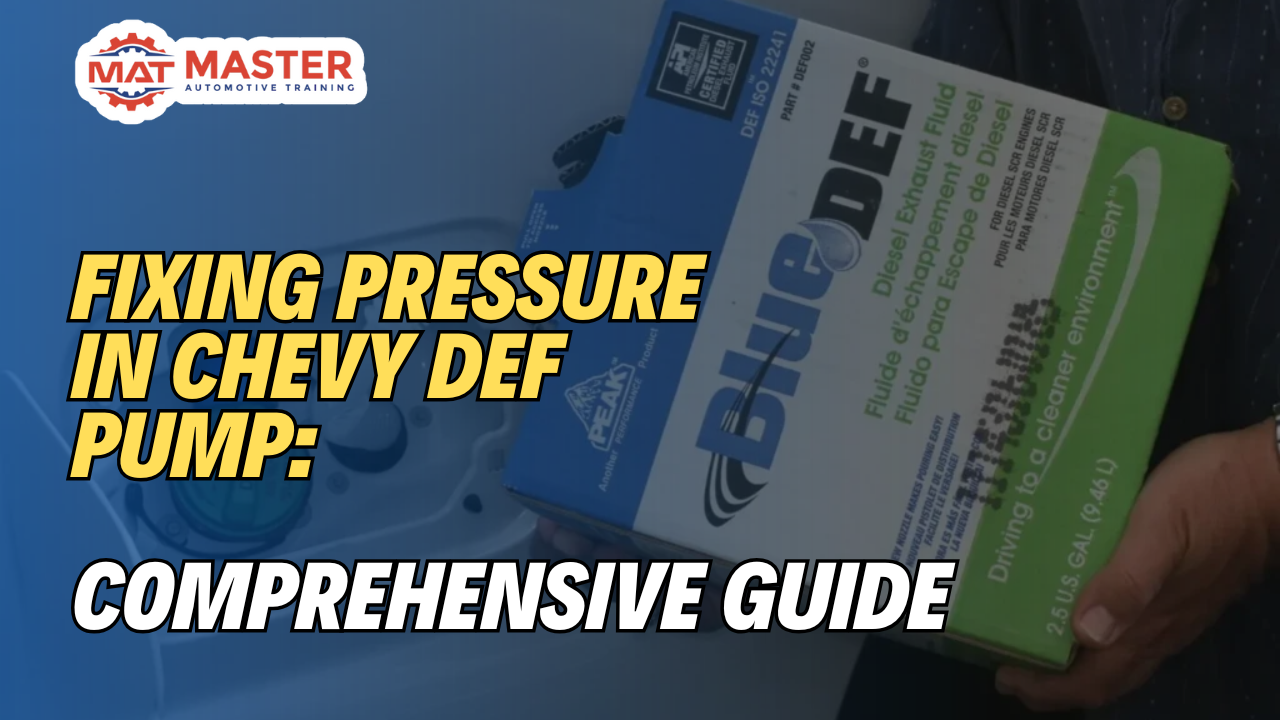 The Diesel Exhaust Fluid (DEF) system in your Chevy is crucial for reducing emissions and ensuring your vehicle meets environmental standards. However, issues with pressure in the DEF pump can lead to performance problems and potentially trigger warning lights on your dashboard. This guide will help you understand how to diagnose and fix pressure issues in your Chevy DEF pump, ensuring your vehicle runs smoothly and efficiently.
The Diesel Exhaust Fluid (DEF) system in your Chevy is crucial for reducing emissions and ensuring your vehicle meets environmental standards. However, issues with pressure in the DEF pump can lead to performance problems and potentially trigger warning lights on your dashboard. This guide will help you understand how to diagnose and fix pressure issues in your Chevy DEF pump, ensuring your vehicle runs smoothly and efficiently.
Understanding the DEF System
The DEF system works by injecting a solution of urea and water into the exhaust stream to convert harmful nitrogen oxides (NOx) into harmless nitrogen and water vapor. The DEF pump is responsible for delivering the fluid from the tank to the injector. Proper pressure in this system is vital for efficient operation.
Common Symptoms of DEF Pump Pressure Issues
Before diving into repairs, it’s essential to recognize the signs that indicate a problem with the DEF pump pressure:
- Warning Lights: Check engine or DEF system warning lights may illuminate on your dashboard.
- Poor Engine Performance: Reduced power or efficiency can occur when the DEF system isn’t functioning correctly.
- Frequent Regeneration Cycles: An increase in the frequency of regeneration cycles may indicate issues with the DEF system.
Tools and Materials Needed
To fix pressure issues in your Chevy DEF pump, gather the following tools and materials:
- OBD-II scanner
- Multimeter
- Socket set
- Wrenches
- New DEF pump (if necessary)
- DEF fluid
- Rags and cleaning supplies
Step-by-Step Guide to Fixing Pressure in the DEF Pump
Step 1: Safety First
Before starting any diagnostic or repair work, prioritize safety. Park your vehicle on a flat surface, engage the parking brake, and wear safety gear like gloves and safety glasses.
Step 2: Scan for Diagnostic Trouble Codes (DTCs)
Using an OBD-II scanner, check for any diagnostic trouble codes related to the DEF system. Common codes may include those indicating pressure issues or pump malfunctions. Document any codes for reference during troubleshooting.
Step 3: Inspect the DEF Pump and System
- Locate the DEF Pump: Usually found near the DEF tank, the pump may be accessible from underneath the vehicle or through the engine compartment.
- Check for Leaks: Inspect the pump and surrounding hoses for any signs of leaks or damage. Look for cracked hoses or loose connections that could affect pressure.
- Electrical Connections: Ensure that the electrical connectors to the pump are secure and free of corrosion. Use a multimeter to test for proper voltage and ground.
Step 4: Test the DEF Pump
To check if the pump is functioning correctly, you can perform a pressure test:
- Disconnect the DEF Lines: Carefully disconnect the supply and return lines from the pump. Be prepared for some fluid spillage.
- Test the Pump: Using a multimeter, check the pump’s voltage while someone turns the ignition to the “ON” position (without starting the engine). Ensure the pump receives power.
- Bench Test the Pump: If possible, remove the pump and connect it directly to a power source to see if it operates. If it doesn’t work, it may need replacement.
Step 5: Replace the DEF Pump (if necessary)
If testing indicates that the DEF pump is faulty, follow these steps to replace it:
- Remove the Old Pump: Disconnect any remaining hoses and electrical connections. Remove the mounting bolts and take out the defective pump.
- Install the New Pump: Position the new pump in place, secure it with bolts, and reconnect all hoses and electrical connections.
- Refill the DEF Tank: Make sure the DEF tank is filled with the appropriate DEF fluid.
Step 6: Clear Codes and Test Drive
After completing repairs, use the OBD-II scanner to clear any stored diagnostic trouble codes. Take your Chevy for a test drive, monitoring for any warning lights or performance issues.
Step 7: Regular Maintenance
To prevent future issues, regularly check the DEF fluid level and ensure there are no leaks in the system. Keeping the DEF system in good condition will help your vehicle operate efficiently and meet emissions standards.
Conclusion
Fixing pressure issues in your Chevy DEF pump is essential for maintaining your vehicle’s performance and compliance with emission regulations. By following this guide, you can diagnose problems and make necessary repairs, ensuring your DEF system functions effectively. If you encounter any persistent issues or are unsure about any steps, it’s always best to consult a professional mechanic. Keeping your vehicle well-maintained not only enhances its performance but also contributes to a cleaner environment. Happy driving!
